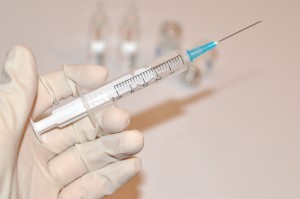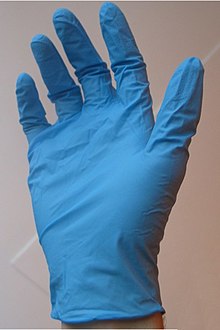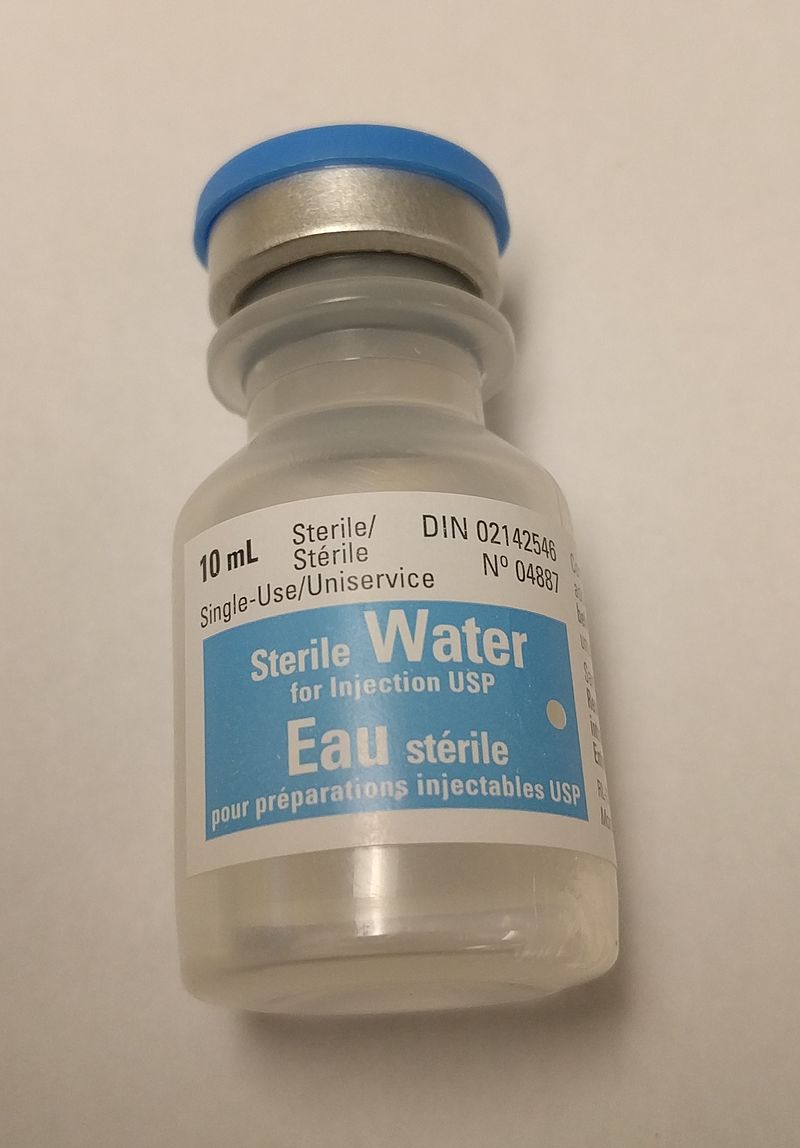Injection: Difference between revisions
| Line 25: | Line 25: | ||
|} | |} | ||
== Intramuscular Injection == | |||
This method of injection is typically used for drugs for which speedy onset is not appropriate. The main 'street' drug injected intramuscularly is ketamine. Muscle is highly vascular, meaning it is well supplied with blood vessels, yet acts as a reservoir for the injected drug, releasing it gradually into the bloodstream. Onset is typically within a matter of 5 to 15 minutes. | |||
For intramuscular injection you will need a relatively long needle, more than 2 centimetres. 21 or 23G is the recommended gauge used by the NHS. Before you inject, inspect your surroundings for danger. Ensure there is nothing lying around to trip on, slip on, or hit your head on. Inject in a position that you can sit or lie down from, after drug administration. | |||
* Don your gloves and use an alcohol swab to sterilise the injection site (see diagram), the gloves themselves and any other equipment that has not come in sterile packaging. | |||
*If you do not have a solution of your drug, then you will need to work out the minimum amount of liquid required to dissolve the dose. This varies by the solubility of the drug in water. Weigh out the correct dose and place it into a container you have sterilised beforehand. Some injection centres offer disposable 'cookers' for this purpose, but you can also use a spoon. | |||
*Remove the syringe and needle from their respective packaging. Affix the needle to the syringe. It is likely a 'luer lock' device, which attaches by screwing on. | |||
* Draw up the necessary amount of liquid, and gently press down the plunger to eject it onto the dose of drug. You may need to stir the mixture gently to ensure it all dissolves. Do not inject if the substance has not entirely dissolved, add more water until it is entirely liquid. | |||
* Draw up the solution of the drug into the syringe taking care not to touch any part of the syringe to non-sterile surfaces. If you have a solution of your drug simply draw up the appropriate dose from the bottle. Where possible avoid drawing air into the syringe. | |||
* Invert the syringe and visually inspect for bubbles. If any are present, flick the barrel of the syringe to dislodge them and cause them to rise towards the needle. Depress the plunger slightly until you see liquid exit, to ensure any air has cleared the syringe. Injecting a small quantity of air intramuscularly is not extremely dangerous but it is best practice to avoid it. | |||
* Pull the skin above the injection site taut and insert the needle into the body at a right angle to the skin. Draw the plunger back slightly and check for any blood (there should not be a large amount of blood entering the syringe, this indicates the needle is inside a blood vessel). If the barrel is clear, depress the plunger gently. Avoid injecting rapidly as this can be uncomfortable. | |||
* Allow the needle to sit in the skin for a few seconds, then withdraw it and allow the skin to relax again. This will allow the layers of skin, fascia and muscle to slide over each other, sealing the drug inside the muscle | |||
* Immediately re-cap the needle, and place gauze or a plaster/band-aid on the wound. Place the syringe somewhere safe for disposal and lie down. The drug will take effect rapidly, do not attempt to walk around, you may collapse. | |||
Revision as of 18:03, 8 November 2017
Some drug users may choose to inject drugs into the body using hypodermic needles. This is normally done due to achieve accelerated onset or greater bioavailability. It must be noted, however, that injecting drugs, especially intravenously, increases risk in multiple ways, ranging from physical harm to greater addiction potential.
The risks involved are many but range from minor cosmetic damage to the skin at the injection site to serious adverse outcomes like sepsis or vein collapse in poorly performed procedures or too frequent use of intravenous injection in a region. For certain drugs injection also seriously increases the risk of overdose. These are not dangers to be taken lightly and must be taken into account.
There are several methods of injecting drugs, each with a different technique. Not all drugs are injectable, not all drugs are worth injecting, and which method one uses to inject varies by compound. Therefore, whilst it is always essential to research the properties of the drugs you are using, it is especially so when injecting drugs directly into the body. This article assumes you have evaluated the properties of your chosen drug and that you have selected a drug which is appropriate for your chosen technique.
Equipment
Unlike other methods of using drugs, injection requires significant preparation and equipment. Most of the necessary items are available from needle exchanges or online retailers.
| Item | Description | Image |
|---|---|---|
| Needle | These are the hypodermic tips which attach to syringes. They are typically sold separately from syringes, and come in a variety of lengths and diameters depending on the technique they are required for. | |
| Syringe | These are plastic devices which contain a barrel and a plunger. They allow measured amounts of liquid to be pulled into them, and expelled where required. Typically syringes connect to needles via a Luer Lock mechanism. The size of the syringe you require will depend on the type of drug you use, and the volume of liquid required to dissolve an active dose. | 
|
| Gloves | While some people skip using gloves, they are useful in avoiding contamination and protecting against infection. | 
|
| Alcoholic wipes | These are necessary for cleaning your hands and the injection site. | 
|
| Sterile water | This is necessary for dissolving your drug of choice. If your drug is already in pharmaceutical solution this step is not necessary. If you do not have access to sterile water it is possible to boil water for 10 minutes to achieve a relatively sterile solution, although this is inferior to truly sterile solution. | 
|
Intramuscular Injection
This method of injection is typically used for drugs for which speedy onset is not appropriate. The main 'street' drug injected intramuscularly is ketamine. Muscle is highly vascular, meaning it is well supplied with blood vessels, yet acts as a reservoir for the injected drug, releasing it gradually into the bloodstream. Onset is typically within a matter of 5 to 15 minutes.
For intramuscular injection you will need a relatively long needle, more than 2 centimetres. 21 or 23G is the recommended gauge used by the NHS. Before you inject, inspect your surroundings for danger. Ensure there is nothing lying around to trip on, slip on, or hit your head on. Inject in a position that you can sit or lie down from, after drug administration.
- Don your gloves and use an alcohol swab to sterilise the injection site (see diagram), the gloves themselves and any other equipment that has not come in sterile packaging.
- If you do not have a solution of your drug, then you will need to work out the minimum amount of liquid required to dissolve the dose. This varies by the solubility of the drug in water. Weigh out the correct dose and place it into a container you have sterilised beforehand. Some injection centres offer disposable 'cookers' for this purpose, but you can also use a spoon.
- Remove the syringe and needle from their respective packaging. Affix the needle to the syringe. It is likely a 'luer lock' device, which attaches by screwing on.
- Draw up the necessary amount of liquid, and gently press down the plunger to eject it onto the dose of drug. You may need to stir the mixture gently to ensure it all dissolves. Do not inject if the substance has not entirely dissolved, add more water until it is entirely liquid.
- Draw up the solution of the drug into the syringe taking care not to touch any part of the syringe to non-sterile surfaces. If you have a solution of your drug simply draw up the appropriate dose from the bottle. Where possible avoid drawing air into the syringe.
- Invert the syringe and visually inspect for bubbles. If any are present, flick the barrel of the syringe to dislodge them and cause them to rise towards the needle. Depress the plunger slightly until you see liquid exit, to ensure any air has cleared the syringe. Injecting a small quantity of air intramuscularly is not extremely dangerous but it is best practice to avoid it.
- Pull the skin above the injection site taut and insert the needle into the body at a right angle to the skin. Draw the plunger back slightly and check for any blood (there should not be a large amount of blood entering the syringe, this indicates the needle is inside a blood vessel). If the barrel is clear, depress the plunger gently. Avoid injecting rapidly as this can be uncomfortable.
- Allow the needle to sit in the skin for a few seconds, then withdraw it and allow the skin to relax again. This will allow the layers of skin, fascia and muscle to slide over each other, sealing the drug inside the muscle
- Immediately re-cap the needle, and place gauze or a plaster/band-aid on the wound. Place the syringe somewhere safe for disposal and lie down. The drug will take effect rapidly, do not attempt to walk around, you may collapse.
